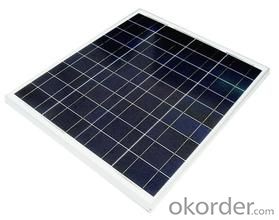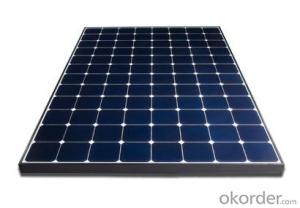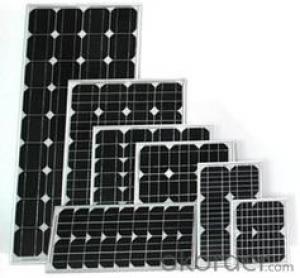CNBM Poly 210W Solar Panel with TUV UL CE Certificate For Residential
- Loading Port:
- Shanghai
- Payment Terms:
- TT OR LC
- Min Order Qty:
- 100 watt
- Supply Capability:
- 1000 watt/month
OKorder Service Pledge
OKorder Financial Service
You Might Also Like
Item specifice
CNBM Poly 210W Solar Panel with TUV UL CE Certificate For Residential
Introduction
Electrical connections are made in series to achieve a desired output voltage and/or in parallel to provide a desired current capability. The conducting wires that take the current off the modules may contain silver, copper or other non-magnetic conductive [transition metals]. The cells must be connected electrically to one another and to the rest of the system. Externally, popular terrestrial usage photovoltaic modules use MC3 (older) or MC4 connectors to facilitate easy weatherproof connections to the rest of the system.
A single solar module can produce only a limited amount of power; most installations contain multiple modules. A photovoltaic system typically includes a panel or an array of solar modules, a solar inverter, and sometimes a battery and/or solar tracker and interconnection wiring.
Micro-inverted solar panels are wired in parallel which produces more output than normal panels which are wired in series with the output of the series determined by the lowest performing panel (this is known as the "Christmas light effect"). Micro-inverters work independently so each panel contributes its maximum possible output given the available sunlight.[6

Suggested application
Home lighting business lighting,
Garden lighting, pavement lighting
Farmer household lighting
Decorative water pump
Traffic signal lighting
Industry area
Business area
Solar Power Plant
Product feature
Modules are made of Monocrystalline or Polycrystalline Silicon cell.
Materials and color of the solar panel frame: Clear anodized aluminum alloy type 6063T5 Universal frame; Silver-white color;
The output connection gathers the coupling: Selects conforms to the IEC-612615; 2005, class II, IEC61730 international standard; Airtight waterproofing binding clamp;
Module seal structure: The surface is thick, the high diaphanous rate armored glass with solar cell board special-purpose 3.2mm becomes after the high temperature lamination craft. The back selects has waterproof and anti- aged performance fine TPT materials. The entire block battery board has, the waterproofing, the anti- aging airtight and so on the fine performance;
Power tolerance: +/-3%
Packaging
International standard cartons (according to the requirements of customers)
- Q:i need someone to advice me which solar panels to buy.i have looked into few companies and i need some more info before decidingthe companies i checked were Sun tech trina solar Canadian solar and LDK solar.whice company should i pick?? please help.
- I did that 25 years in the past and happy I did. they're nonetheless operating high quality with little upkeep. we stay in necessary large apple so we've about an same type of cloud cover you do, and at the same time as that is no longer suitable, you could make it artwork. the nice and comfy button isn't spending plenty so that you've a life like payback time. I designed and outfitted my own, yet i did not layout for top performance; and at the same time as it would not generate all our warm water each and each of the time, it takes the edge off our gas bill. locate someone who has them and note if it paid off for them. don't be the first to get them until eventually you opt for to do slightly engineering. image voltaic voltaic panels could no longer be used to warmth water electrically, that is truly inefficient and could no longer payback. DHW heating is low-tech and all and dissimilar needs warm water. Voltaics receives extra valuable in years yet to go back, and expenditures are dropping so it would not make experience to purchase now.
- Q:How long does it take to install solar panels?
- The installation process for solar panels typically takes one to three days, depending on the size and complexity of the system, as well as the availability of skilled installers.
- Q:Can solar panels be used in areas with high levels of air pollution?
- Yes, solar panels can still be used in areas with high levels of air pollution. While air pollution can reduce the efficiency of solar panels, they can still generate electricity even in polluted environments. However, regular cleaning and maintenance may be required to ensure optimal performance in such areas.
- Q:Can solar panels be installed on a church or place of worship?
- Yes, solar panels can be installed on a church or place of worship. In fact, many religious institutions have embraced solar energy as a sustainable and environmentally-friendly solution for their energy needs. Installing solar panels on a church can help reduce energy costs, lower carbon footprint, and demonstrate a commitment to stewardship of the earth's resources. Additionally, solar panels on a place of worship can serve as a symbol of the institution's values and inspire the community to adopt clean energy practices.
- Q:I'm looking into buying solar panels, there are all kinds of ranges of energy output...but my question is, when ti says...say 50 watts of power...does that mean 50 watts a day, an hour, a minute, what?
- A 50-watt rating means the panel will produce 50 watts as long as the standard conditions are maintained. So if you had this bright sun and cool temperatures for 6 hours, the panel would deliver 50 x 6 = 900 watt hours, or a little shy of kilowatt-hour. Kilowatt-hours (kWh) is the reading on your electric bill. However, like most advertising, the 50-watt number is not realistic. They assume that the air surrounding the panel is very cold. 25 watts is a better number to use for this size of panel for engineering purposes.
- Q:What are the advantages of using solar panels?
- There are several advantages of using solar panels. Firstly, solar panels produce clean and renewable energy, which helps reduce greenhouse gas emissions and combat climate change. Secondly, solar energy is abundant and free, reducing the dependence on fossil fuels and providing a sustainable source of power. Additionally, solar panels can save homeowners and businesses money on their electricity bills by generating their own energy. Finally, solar panels require minimal maintenance and have a long lifespan, making them a cost-effective and reliable energy solution.
- Q:Can solar panels be installed on assisted living facilities?
- Yes, solar panels can be installed on assisted living facilities. In fact, installing solar panels on such facilities can be a great way to reduce operating costs, promote sustainability, and provide a clean source of energy.
- Q:What things can a solar panel power?
- Add up the Watts, listed on the nameplate of each item, and compare that to the wattage of the solar panels, watts/square foot times number of square feet of panels. That will give you the most your panels can power if everything is on at the same time, the sun is at its brightest, and there are no losses in the system. Then you've got your storage capacity and inverter capacity to consider. If you've only got 8 hours a day of sunlight, then you need 3 times the area to cover the other 6 hours in the day. Although you are unlikely to run everything full bore all the time, neither is the sun a constant. For most people the best actual return on investment can be had by using the panels to store energy in a preheater for the hotwater tank fill line. This avoids the cost of batteries, an inverter, and an automatic throwover switch, as well as the time, trouble and expense of dealing with the power company. If you actually have energy left over, the best way to use it is to charge a battery bank connected to an uninterruptible power supply on your most used and non essential equipment, ie TV and Computers. When you are there, unplug the UPS and run your stuff on the batteries in that. I'm sure a electronic type could build dropout relay that would automatically switch the ups back to line power when the batteries start to run out. You would want to disable the inverter's charge circuit also or it would use line power to charge the batteries.
- Q:Can solar panels be installed on a south-facing wall?
- Yes, solar panels can be installed on a south-facing wall. In fact, a south-facing wall is often the most ideal location for solar panel installation as it receives the most sunlight throughout the day.
- Q:How much energy can a solar panel produce in a day?
- The amount of energy a solar panel can produce in a day depends on various factors such as the size and efficiency of the panel, location, weather conditions, and sunlight exposure. On average, a typical residential solar panel can generate around 4 to 6 kilowatt-hours (kWh) of electricity per day. However, this value can vary significantly and may be higher or lower based on the aforementioned factors.
1. Manufacturer Overview |
|
|---|---|
| Location | |
| Year Established | |
| Annual Output Value | |
| Main Markets | |
| Company Certifications | |
2. Manufacturer Certificates |
|
|---|---|
| a) Certification Name | |
| Range | |
| Reference | |
| Validity Period | |
3. Manufacturer Capability |
|
|---|---|
| a)Trade Capacity | |
| Nearest Port | |
| Export Percentage | |
| No.of Employees in Trade Department | |
| Language Spoken: | |
| b)Factory Information | |
| Factory Size: | |
| No. of Production Lines | |
| Contract Manufacturing | |
| Product Price Range | |
Send your message to us
CNBM Poly 210W Solar Panel with TUV UL CE Certificate For Residential
- Loading Port:
- Shanghai
- Payment Terms:
- TT OR LC
- Min Order Qty:
- 100 watt
- Supply Capability:
- 1000 watt/month
OKorder Service Pledge
OKorder Financial Service
Similar products
New products
Hot products
Related keywords





























